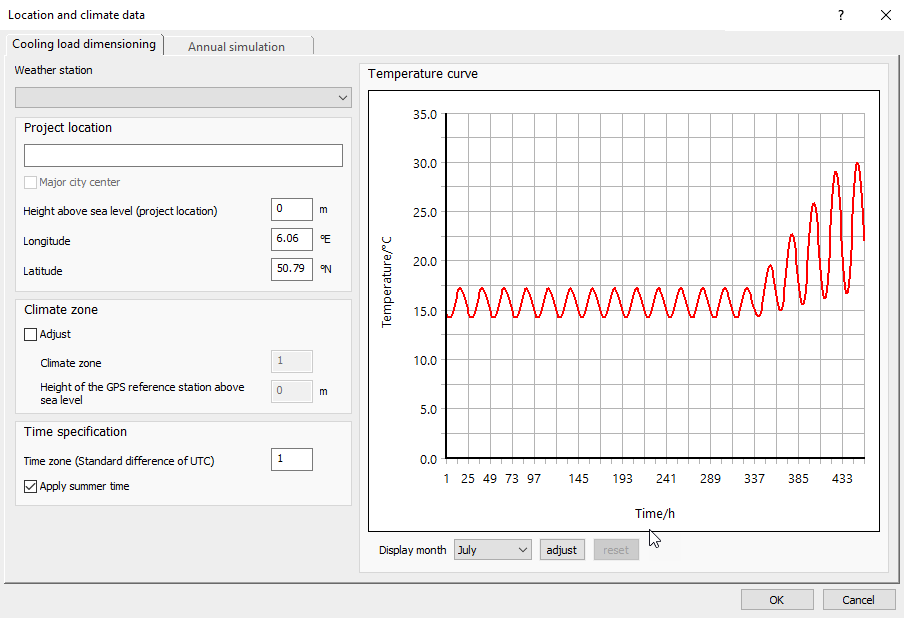Details on Cooling Load Dimensioning in the Location and Climate Data
Information on the Cooling load dimensioning tab in the Location and climate data dialog in the dynamic cooling load calculation.
You are here:

Country / Weather station
Use the Country drop-down list to choose between Germany, Austria or Switzerland. You can then select a location via Weather Station. For Germany, a list of alphabetically sorted cities is available from VDI 2078. For Austria and Switzerland, locations with a population of approx. 10,000 or more are listed.
You can select a place nearby if your project location is not listed. Each location is assigned to one of the four climate zones. For places in climate zones 3 and 4, the option Metropolitan center can be activated. When selecting a location, it is possible to adopt the coordinates of the selected weather station for the project location.
Alternatively, you can load weather data for non-listed locations in TRY file format into the cooling load calculation. The prerequisite for this is that you saved a TRY file of the format DWDTRY-FORMAT V1.2 for the desired project location in the program folder Cooling Load/User-Standards/TRY.
A list of cities with their assignment to climate zones as well as an overview map can be found in VDI 2078, Annex B2.
Project Location
The project location is displayed on the printout. By default, the location of the weather station or the coordinates from the file of the selected test reference year are displayed here. For the printout the project location can be manually adjusted by clicking in the text field.
Metropolitan center
Enabled: The maximum outside temperature and the amplitude of the outside temperature (monthly) are adjusted to account for higher temperatures and lower temperature fluctuations in metropolitan centers.
Elevation above sea level (project location), Longitude, Latitude
The geographical data of the project. By default, the data from the selected weather station location or the data from the file of the selected test reference year are entered. The cooling load calculation with corresponding correction factors takes place from a delta of ≥ 650 m between the elevation of the reference station and the elevation of the project site. The coordinates influence the calculation of solar radiation; depending on elevation and climate zone, outside temperatures are also adjusted. If you know the exact location of your project, you can adjust the coordinates at this point.
Climate Zone Data
Enabled: You can assign the selected location to another Climate zone and adjust the Height of the reference station above sea level. From a delta of ≥ 650 m between the height of the reference station and the height of the project location, the cooling load calculation takes place with corresponding correction factors.
Time Specification
Time zone (Standard difference of UTC): The time zone is local and should not be changed. It refers to the Coordinated Universal Time (UTC) and is used to control the input and output of clock times in the dynamic cooling load calculation. If you calculate the cooling load for a location that is in a different time zone, you can adjust the time zone here.
Apply summer time- activated: The calculation takes into account the time difference due to summer time.
Temperature curve
The temperature curve for the selected weather station is displayed for the selected month, taking into account any adjusted data. If you have selected the option Periodic settling with CDD in the Settings dialog for settling the cooling load calculation, at this point the temperature curve for the CDD of the selected month will be displayed.
Display month: Drop-down list to select the month to be displayed. You can have one of the design months between April and September displayed.
adjust: Opens the Create/adjust temperature curve dialog, where you
-
can adjust the temperature hourly for all 19 days of the CDP in the selected month (aperiodic settling with CDP)
-
can adjust the hourly temperature of the CDD in the selected month (periodic settling with CDD)
In both cases you can alternatively have a temperature curve generated.
reset: Resets an adjusted temperature curve to the original values.